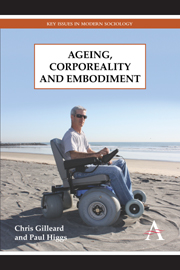Book contents
- Frontmatter
- Contents
- Introduction
- Chapter 1 Identity, Embodiment and the Somatic Turn in the Social Sciences
- Chapter 2 Corporeality, Embodiment and the ‘New Ageing’
- Chapter 3 Gender, Ageing and Embodiment
- Chapter 4 Age and the Racialised Body
- Chapter 5 Disability, Ageing and Identity
- Chapter 6 Sexuality, Ageing and Identity
- Chapter 7 Sex and Ageing
- Chapter 8 Cosmetics, Clothing and Fashionable Ageing
- Chapter 9 Fitness, Exercise and the Ageing Body
- Chapter 10 Ageing and Aspirational Medicine
- Conclusions: Ageing, Forever Embodied
- References
- Index
- ADVANCE PRAISE
Chapter 2 - Corporeality, Embodiment and the ‘New Ageing’
Published online by Cambridge University Press: 05 July 2013
- Frontmatter
- Contents
- Introduction
- Chapter 1 Identity, Embodiment and the Somatic Turn in the Social Sciences
- Chapter 2 Corporeality, Embodiment and the ‘New Ageing’
- Chapter 3 Gender, Ageing and Embodiment
- Chapter 4 Age and the Racialised Body
- Chapter 5 Disability, Ageing and Identity
- Chapter 6 Sexuality, Ageing and Identity
- Chapter 7 Sex and Ageing
- Chapter 8 Cosmetics, Clothing and Fashionable Ageing
- Chapter 9 Fitness, Exercise and the Ageing Body
- Chapter 10 Ageing and Aspirational Medicine
- Conclusions: Ageing, Forever Embodied
- References
- Index
- ADVANCE PRAISE
Summary
For most people, ageing remains a bodily affair. Academic accounts have defined or represented ageing in various ways and from a number of disciplinary perspectives. These have included ‘the accelerating risk of mortality’ (Strehler 1962), ‘the stochastic process of diminishing energy’ (Hayflick 2000), the ‘process of social redundancy’ (Phillipson 1982), ‘marginality’ (Ward 1984) or the loss of ‘role’ in society (Burgess 1960). Still, the decline of the body remains ageing's central motif. The personal and social importance of ageing rests upon the changing status of the body and the implications that this has for identity, life chances and lifestyles. It is the body that seems to house selfhood and define individuality. Bodily ageing seems to efface the very site where the self is constructed under conditions of youth, fitness and potential, replacing it with the corporeal marks of decline and defeat. While population ageing, ageing as ‘risk’ or ‘vulnerability’ and ageing as status change are important academic preoccupations, it is the ageing of bodies that remains the ineradicable concern of persons, confronting, in their own ageing body, the essential transience of their lives.
- Type
- Chapter
- Information
- Ageing, Corporeality and Embodiment , pp. 21 - 32Publisher: Anthem PressPrint publication year: 2013



